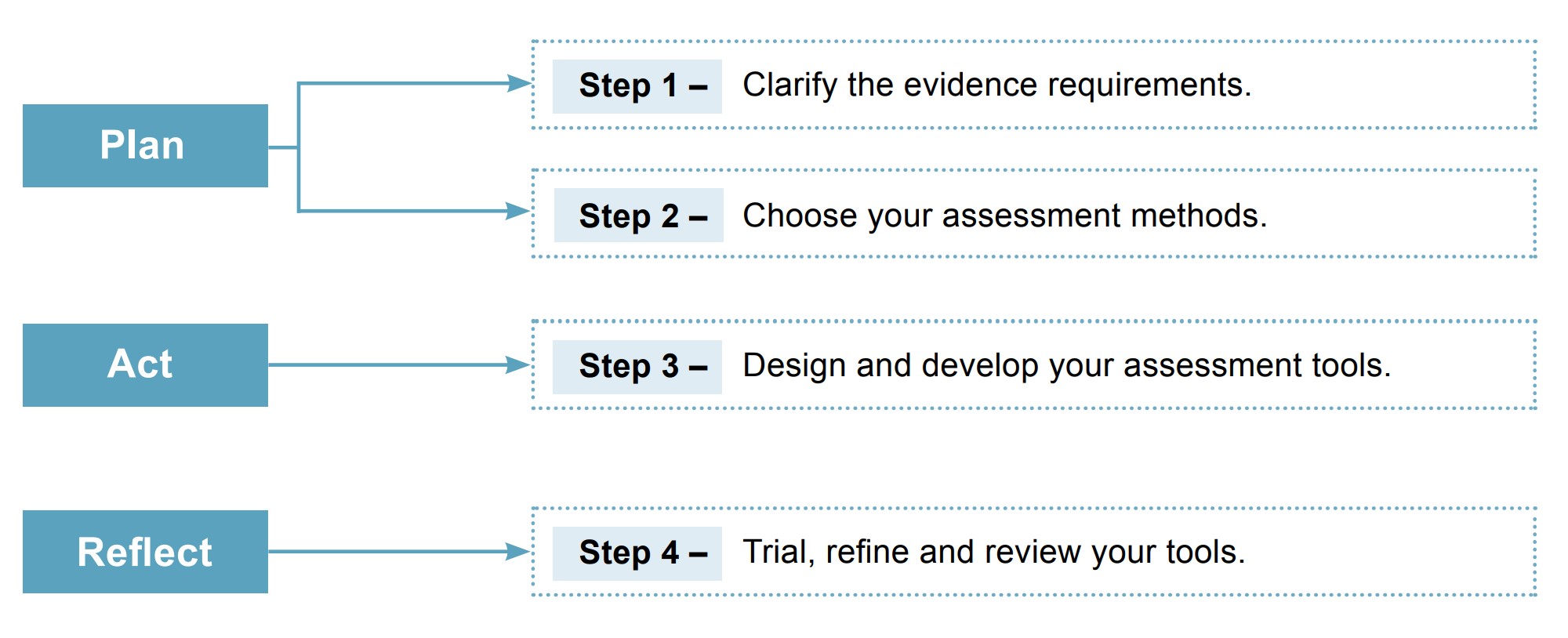ASQA defines assessment as:
The process of collecting evidence and making judgements on whether competency has been achieved to confirm that an individual can perform to the standard expected in the workplace, as specified in a training package or a VET accredited course.
Clause 1.8
The RTO implements an assessment system that ensures that assessment (including recognition of prior learning):
- complies with the assessment requirements of the relevant training package or VET accredited course
- is conducted in accordance with the Principles of Assessment and the Rules of Evidence.
Standards for Registered Training Organisations (RTOs) 2015

Fairness
The individual learner’s needs are considered in the assessment process.
Where appropriate, reasonable adjustments are applied by the RTO to take into account the individual learner’s needs.
The RTO informs the learner about the assessment process, and provides the learner with the opportunity to challenge the result of the assessment and be reassessed if necessary.
Flexibility
Assessment is flexible to the individual learner by:
- reflecting the learner’s needs
- assessing competencies held by the learner no matter how or where they have been acquired
- drawing from a range of assessment methods and using those that are appropriate to the context, the unit of competency and associated assessment requirements, and the individual.
Validity
Any assessment decision of the RTO is justified, based on the evidence of performance of the individual learner.
Validity requires:
- assessment against the unit/s of competency and the associated assessment requirements covers the broad range of skills and knowledge that are essential to competent performance
- assessment of knowledge and skills is integrated with their practical application
- assessment to be based on evidence that demonstrates that a learner could demonstrate these skills and knowledge in other similar situations
- judgement of competence is based on evidence of learner performance that is aligned to the unit/s of competency and associated assessment requirements.
Reliability
Evidence presented for assessment is consistently interpreted and assessment results are comparable irrespective of the assessor conducting the assessment.

Validity
The assessor is assured that the learner has the skills, knowledge and attributes as described in the module or unit of competency and associated assessment requirements.
Sufficiency
The assessor is assured that the quality, quantity and relevance of the assessment evidence enables a judgement to be made of a learner’s competency.
Authenticity
The assessor is assured that the evidence presented for assessment is the learner’s own work.
Currency
The assessor is assured that the assessment evidence demonstrates current competency. This requires the assessment evidence to be from the present or the very recent past.

4 Steps to constructing quality assessments
The quality of an assessment tool will depend on how much time and effort goes into researching during the development phase. Just as important is an ongoing cycle of reviewing and refining (pre and post-release).

Step 1
Clarify the evidence requirements
Familiarising yourself with the mandatory requirements of the assessment task(s).
Start by delving into the unit of competency or subject outline to discover any specific assessment requirements. Examine any available information sources such as Training and Assessment Strategy or Program Outline.
Example
Skills must be demonstrated in the workplace. A set task must be performed in at least 3 different situations.
Next, test your own understanding of the requirements of the unit by visualising a competent person at work.
- What tasks will the person perform and manage?
- What contingencies might arise?
- In what contexts are they likely to apply their skills?
- What employability and foundation skills will be needed to complete these tasks?
Find opportunities to consult with relevant industries and subject matter experts (SME).
Examine the benchmarks
Benchmarks are the standards against which a learner is assessed.
Example
Sell products to customers
Knowing the benchmarks will enable you to determine what evidence is required. Evidence is the information which, when matched against the benchmarks, shows that a learner is competent.
Example
What is the learner’s product knowledge? Customer service/selling skills.
Once you have determined the benchmarks and evidence requirements, it's time to decide which assessment method is the most appropriate to gather the evidence.
Step 2
Choose your assessment methods
Using your understanding of the specified competencies to choose appropriate assessment method(s). It is important to also consider the needs of students, take into account their circumstances for example mature adults, balancing work and study, remote online learners working towards career progression or career change, may or may not have access to a workplace, completing the assessment in the evenings or weekends, reliant on the internet and technology to succeed.
Whatever adjustments you make to the assessment to meet student needs, you must ensure that the evidence collected still addresses all the requirements.
A good assessment task may involve using a number of methods to reflect a real work task or a particular job role.
Before you design your assessment tools, take time to consider whether the assessment methods you have selected meet the principles of assessment. Your assessment methods must be:
- valid - assess what they say they do
- reliable - other trainers/assessors would make the same judgement with the same evidence
- flexible - learners’ needs are taken into account in terms of the methods, the time and the place
- fair - allow all learners to demonstrate their competence.

Step 3
Design and develop your assessment tools
Getting down to business and devising the assessment tool(s).
Assessment tools contain both the instrument and the instructions or procedures for gathering and interpreting evidence. They serve the evidence gatherer’s needs for objectivity and transparency as well as the learners’ needs for clarity and structure. Assessment tools should provide clear guidance and support for learners so that there is no ambiguity about what is required of them or the basis on which trainers/assessors will make decisions. They can also, if well designed, be used for recording and reporting purposes.
The tools that you design must comply with the rules of evidence. For example, the tool must facilitate the gathering of evidence that is:
- valid - covers all requirements of the unit of competency
- sufficient - enables you to make a decision about competence over time and in different situations
- current - competent performance is contemporaneous
- authentic - is the learner’s own work.
Instructions
Instructions for the students and the trainer/assessor are an integral part of all assessment tools. Instructions should respond to questions regarding the ‘what, when, where, how and why’ of assessment processes. You might include suggestions on reasonable adjustment to accommodate diversity and/or advice on your recording requirements for the trainer/assessor/observer. These instructions – which should be written in plain English and formated clearly with white space and simple steps. Instructions can be included natively in the LMS or in a separate document.
Reasonable adjustments
Registered training organisations are required to comply with the Standards for Registered Training Organisations (RTOs) 2015, the Disability Discrimination Act 1992 (DDA), and the Disability Standards for Education 2005 when providing services for students who may have a disability.
Reasonable adjustments are made to ensure equity in the assessment process. An assessment can be adjusted to accommodate the needs of an individual learner, such as providing oral rather than a written questioning, but the validity of the assessment process cannot be compromised.
Reasonable adjustments should be negotiated effectively—they are very individual. Usually the person with disability will be the best person to explain the impact of their disability on their study and what adjustments may help them, or they have found useful in the past. You can also ask students to provide documentation from a medical or other health professional to help guide this process.
Examples of reasonable adjustments an RTO might make include providing:
- course material in alternate formats - electronic screen reader, print, braille
- extra time or extensions for assessments
- alternate assessment tasks
- use of assistive technology
- closed captions on videos
- scripts in place of audio recordings
- an Auslan interpreter during webinars or
- other adjustments.
A Fact Sheet 'Providing quality training and assessment services to students with disabilities', developed by ASQA in conjunction with the https://www.education.gov.au/national-disability-coordination-officer-programmehttps://www.education.gov.au/national-disability-coordination-officer-programme at the Western Sydney University, was published on 12 May 2016. It explains:
Inherent requirements are the fundamental parts of a course that must be met by all students in order for them to be deemed competent. They are the abilities, skills and knowledge students need to complete the course — those components which, if removed, would compromise the learning outcomes. Students with disability should be provided with reasonable adjustments to enable them to meet these inherent requirements, provided this would not cause unjustifiable hardship to the RTO. However, if a student cannot meet the inherent requirements, even with adjustments, then they cannot complete the course.

Mapping
Aligning your assessment tools to the unit/subject ensures that the evidence collected completely addresses all requirements. When being reviewed internally or as part of an audit, quality mapping will contribute to the decision that evidence valid and sufficient.
The more detailed the mapping document, the more usable it is for both validation and any redevelopment activities as the unit is updated. Good mapping will save time and effort for multiple people, including the Learning Designer in the future.
Workplace Assessment
Some units of competency require assessment to be conducted in a workplace by observation. Where an assessor is unable to attend a workplace to conduct assessment, RTOs can give consideration to real-time observation via other mediums. For example, an RTO can:
- use video recordings (from recording on a phone to or recording directly into any device using the LMS)
- use Zoom, MS Teams and other video conferencing software.
If a student is working, assessors can view that student’s participation in activities remotely and, using the same observation checklists they have when on site, continue to make valid and sufficient judgements.
Using third parties to collect evidence of competency
In cases where the assessor cannot directly gather all the required evidence to support a competency judgement, the evidence may be able to be gathered or reported by other people (most commonly, a workplace supervisor).
ASQA has published a guide for RTOs on using other parties to collect assessment evidence.
Simulated workplaces
In some instances, assessment conditions allow for assessment normally conducted in the workplace to be carried out in a simulated environment.
Whenever a simulated assessment is conducted it is essential that the environment reflects those typically found in the workplace to be as realistic as possible. Assessment must be conducted in the specified environment using the equipment and resources mandated in the Assessment Conditions field of the Assessment Requirements. Assessment activities must also be realistic and reasonable in terms of scale.
Where simulation is allowed, you must review the specific training package requirements to determine if the learner can accurately replicate a simulated workplace environment from a remote location.
Real-time video-based assessment can be useful for role-play scenarios where students have to react, particularly in circumstances where assessment requirements specify the need for oral assessment.
Before an assessment is undertaken in a simulated environment, the Learning Designer and Assessors need to ensure all equipment is in place. For example, workplace policies and procedures or other realistic workplace documents. In this example, the Learning Designer would need to provide these as part of the Assessment Tool. In comparison to if the equipment was kitchen fixtures, such as work benches, a refrigeration unit and storage facilities, then the Assessor will need to ensure the student has access to these. In both examples, the Learning Designer is required to develop assessment instructions that are clear and explicit to the student and the assessor in regards to what is needed for each assessment task in advance.
Advice about conducting assessment in a simulated environment to give context to the specific requirements of the assessment conditions can often be found in the Training Package Companion Volumes.
www.asqa.gov.au/distance-learning/training-and-assessment

Recognition of prior learning
Recognition of prior learning Recognition of prior learning (RPL) is an assessment process that assesses a person’s formal, non-formal and informal learning to determine the extent to which they have met the requirements specified in a unit of competency or accredited module without the need to undertake a structured learning program. One of the key elements of Australia’s VET system is its flexibility, and the availability of RPL support for those who have learned skills in other settings is a good example. This level of flexibility makes it an attractive option to students and employers.
Step 4
Trial, refine and review your tools
Trialling and refining your tools to help you maximise confidence that the tool(s) can be used flexibly and help you to make valid, reliable and fair judgements.
Learning Designers will be provided access to relevant SMEs and Faculty members of the respective issuing partner. These stakeholders will review all learning content, assessments tool and mapping, to ensure quilty and compliant tools are ready to be built into the LMS. Continuous improvement starts from step, when the Learning Designer is reviewing the requirements, right up until the initial draft documents being reviewed by faculty and SMEs then refined by the LD and added into the LMS.
The cycle continues beyond this and includes gathering feedback from trainers/assessors, students and industry. Any evaluations and/or amendments should be documented by the Lead Learning Designer or allocated LD.
Adapted from 'Assessment in the VET sector' © VET (WA) Ministerial Corporation 2016

Australian Government Department of Education and Training - Assessment Fact Sheet www.myskills.gov.au

